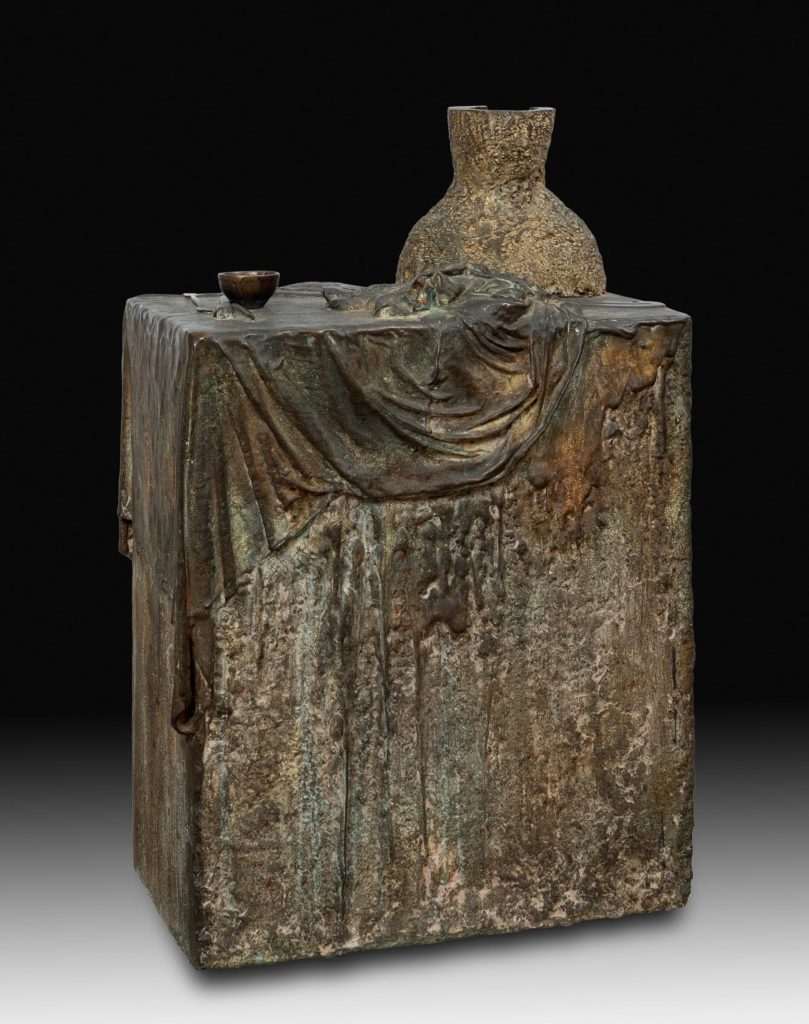This is custom heading element
In the mid-eighties Josep María Subirachs was at the best moment of his career, when he began the first sketches for the sculptural group of the Passion facade of the Sagrada Familia. In parallel to the large public commissions, he carries out sculptures based on the theme of the “workshop corner”, like the one at hand, entitled “El motlle” (1985).
It is a bronze piece representing a shelf covered with a fine cloth, draped with attractive folds, on which the workshop utensils rest (a pencil, a brush and a bowl dripping paint on its outer walls) and, on the other end of the table, a bust worked with a female image in negative, as is usual in the author’s work.
Despite the naturalistic treatment of the objects, the theme of the still life is impregnated with metaphysical cadences, inherent to the work of the Barcelona sculptor. It is a unique piece, signed by the artist and by the founder Manuel Parellada.
Subirach’s personality, which was defined by a group of contrasts and dualisms between painting and sculpture, between figure and symbol, is expressed in this piece in a masterful and suggestive way.

JOSEP MARIA SUBIRACHS SITJAR (Barcelona, 1927-2014) was a sculptor , painter , tape recorder , scenographer Y art critic Spanish . He was one of the contemporary Spanish sculptors with the most international prestige, as can be seen in his multiple awards and recognitions received, as well as in the presence of his work in numerous museums and public places in cities around the world, mainly Barcelona. He also participated in a large number of group and individual exhibitions, in museums and public and private galleries. After entering at the age of fourteen in the workshop of a gilder who was fond of sculpture, where he modeled his first works in clay, in 1942 he entered the workshop of the sculptor Enrique Monjó as an apprentice.

Five years later, he began working as an assistant to Enrique Casanovas. In 1948 he made his debut at Casa del Libro in Barcelona, and in 1951 he traveled to Paris to complete his training, receiving a grant from the French Institute of Barcelona. He returned to his hometown in 1953 and was honored with the Jazz Salon Prize for Sculpture. After two years working and exhibiting in Belgium, he returned to Spain, and in 1958 he was awarded the San Jorge Grand Prize from the Barcelona Provincial Council and the “Julio González” from the Barcelona Chamber of Art. He has had numerous solo and group exhibitions in Europe, Asia and the United States, and in 1988 he was awarded the Medal of Merit in Fine Arts. In 1980 he was elected a member of the Royal Academy of Fine Arts of San Jorge. It is represented at the Reina Sofía Center, the MACBA Museums in Barcelona, Ibiza, Seville and New York, the Fine Arts Museums in Bilbao, Birmingham, the Vatican, Taipei and Nebraska, the Open Air Museum on Paseo de la Castellana in Madrid, the Museum du Petit Palais in Geneva and the Millesgärden in Stockholm, among others.


